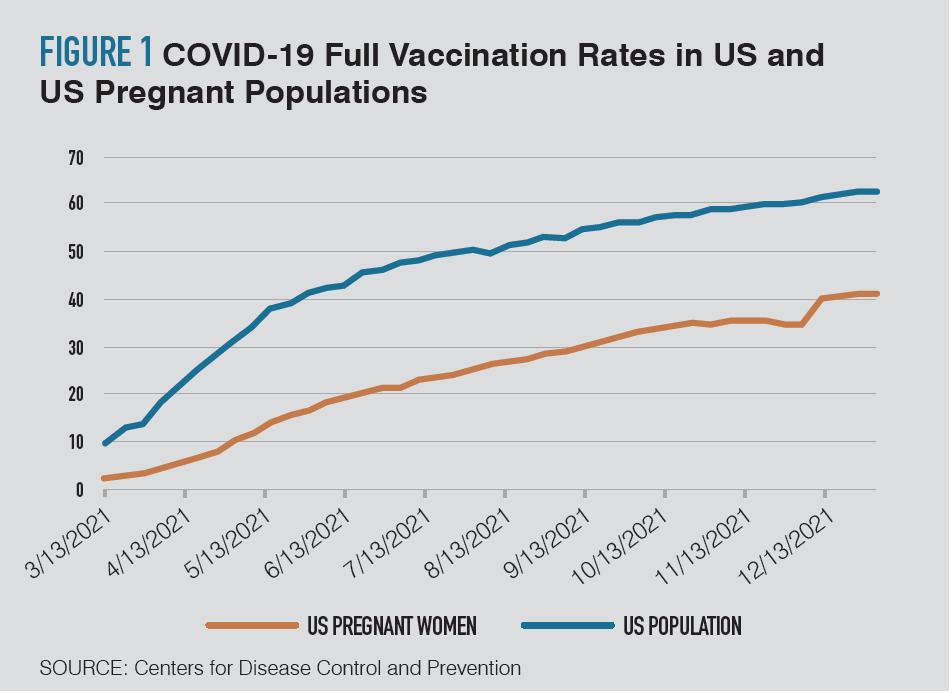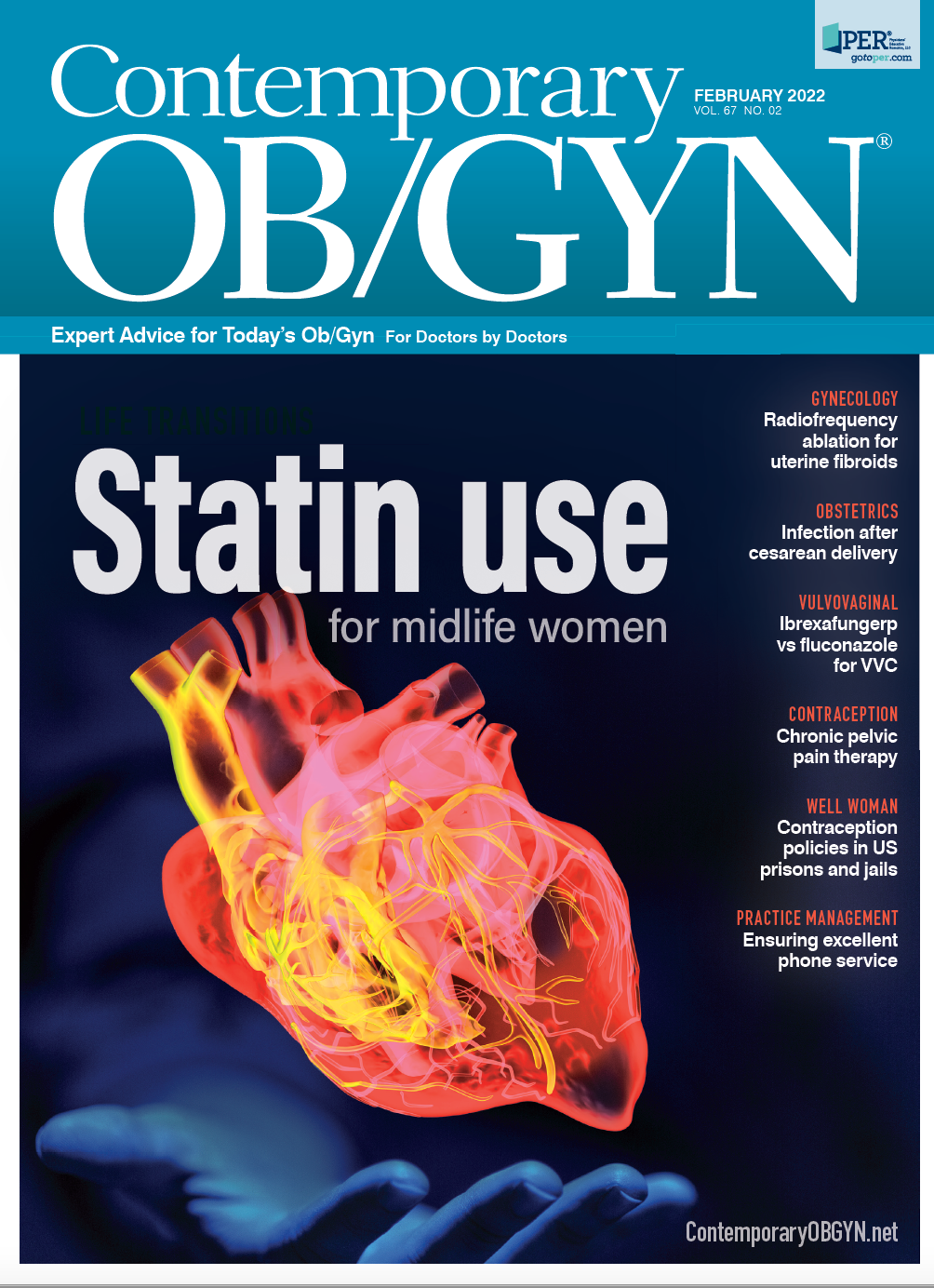Vaccination: Protecting our most vulnerable
For more than 70 years, vaccination has been a public health strategy for disease mitigation. Even in populations often considered “vulnerable”—children and pregnant women—vaccination is strongly recommended and commonly embraced.
Vaccinations for measles, mumps, rubella, and pertussis, to name a few, are routinely administered to children. Influenza and tetanus toxoid, reduced diphtheria toxoid, and acellular pertussis (Tdap) vaccines should be administered in pregnancy, as recommended by professional organizations including the American College of Obstetricians and Gynecologists and the Advisory Council on Immunization Practices. Both vaccines are standard inoculations in pregnancy, decreasing the risk of influenza and pertussis in pregnant women and their infants.
Figure 1: COVID-19 Full Vaccination Rates in US and US Pregnant Populations. SOURCE: Centers for Disease Control and Prevention

COVID-19 vaccination is also recommended for pregnant women; however, to date, vaccinations lag in this group (Figure 1). Because of the Omicron surge, infection in pregnancy has skyrocketed. We are seeing a more than 500% increase in COVID-19 diagnoses. Thankfully, the severity with Omicron is much lower than with the Delta variant.1 It is not, however, without an impact on our field, as the donning and doffing of personnel protective equipment and the deluge of patients are not insignificant and are further taking a toll on providers—both physicians and nurses. With this new surge in cases, the light at the end of the tunnel for this pandemic seems more distant than ever.
The latest COVID-19 vaccination numbers from the Centers for Disease Control and Prevention (CDC) reveal that, as of this writing, 62.5% of the US population are fully vaccinated, 74.3% have received at least 1 dose, and 36.3% have received booster doses.2 This is in contrast to pregnant women (aged 18-49 years), who are at less than one-third the rate, with just 41.5% fully vaccinated; of these, about half received their vaccinations prior to pregnancy.3
Despite demonstrated effectiveness and—for Tdap—benefits that extend to the infant, a 2021 survey by the CDC reports disappointing uptake of even non–COVID-19 vaccination in pregnancy.2 Of 1795 pregnant women between October 2020 and January 2021, just 55% received influenza and 53.5% received Tdap vaccinations. Furthermore, just 30.7% received both influenza and Tdap vaccines. These rates are relatively stagnant, as data from 2017 report Tdap vaccination in pregnancy at 50.4%.4 These rates pale in comparison with vaccinations in children: More than 80% are vaccinated for diphtheria, tetanus, and pertussis, and more than 90% are vaccinated for polio, measles, mumps, rubella, hepatitis B, and chickenpox.5 Furthermore, 46.8% of adults are vaccinated for influenza, and 68.9% over age 65 years have received a pneumococcal vaccination (Figure 2).6
Despite numerous efforts to advocate for including pregnant and lactating women in research, both groups were again excluded from research on the COVID-19 vaccines and therapeutics. Even with official recommendations for COVID-19 vaccination in pregnancy, it has been difficult to implement. Importantly, influenza and Tdap vaccinations in pregnancy were highest in women when the provider offered or referred for vaccination (influenza, 68.1%; Tdap, 69.9%).7 This opens an avenue forward: We as providers can make a difference for our patients by advocating and encouraging vaccination, providing the data on efficacy and impact on the health of both the woman and her infant. It is imperative that we break through the political issues associated with COVID-19 vaccination and directly provide the guidance to our patients.
References
- Adhikari EH, SoRelle JA, McIntire DD, Spong CY. Increasing severity of COVID-19 in pregnancy with Delta (B.1.617.2) variant surge. Am J Obstet Gynecol. 2022;226(1):149-151. doi:10.1016/j.ajog.2021.09.008
- COVID-19 vaccinations in the United States. Centers for Disease Control and Prevention. March 28, 2020. Accessed January 10, 2022. https://covid.cdc.gov/covid-data-tracker/#vaccinations_vacc-total-admin-rate-total
- COVID-19 vaccination among pregnant people aged 18-49 years overall, by race/ethnicity, and date reported to CDC – vaccine safety datalink United States. Centers for Disease Control and Prevention. January 15, 2021. Accessed January 10, 2022. https://covid.cdc.gov/covid-data-tracker/#vaccinations-pregnant-women
- Tdap vaccine. Centers for Disease Control and Prevention. Updated August 15, 2017. Accessed January 10, 2022. https://www.cdc.gov/vaccines/pregnancy/hcp-toolkit/tdap-report.html
- Immunization. Centers for Disease Control and Prevention. Updated August 3, 2021. Accessed January 10, 2022. https://www.cdc.gov/nchs/fastats/immunize.htm
- Influenza. Centers for Disease Control and Prevention. Updated August 3, 2021. Accessed January 10, 2022. https://www.cdc.gov/nchs/fastats/flu.htm
- Flu and Tdap vaccination coverage among pregnant women – United States, April 2021. Centers for Disease Control and Prevention. Updated October 7, 2021. Accessed January 10, 2022. https://www.cdc.gov/flu/fluvaxview/pregnant-women-apr2021.htm

Contemporary OB/GYN Senior Editor Angie DeRosa gets insight on the current state of COVID-19 from Christina Han, MD, division director of maternal-fetal medicine at the University of California, Los Angeles, and member of its COVID-19 task force. Han is an active member of the Society for Maternal-Fetal Medicine and discusses the issues on behalf of SMFM.
Listen
Study links COVID-19 infection to higher low birthweight and preterm birth rates
March 24th 2025A new study found that pregnant women infected with COVID-19, especially in the third trimester or with severe symptoms, faced higher risks of preterm birth, low birthweight, and neonatal intensive care unit admission.
Read More
